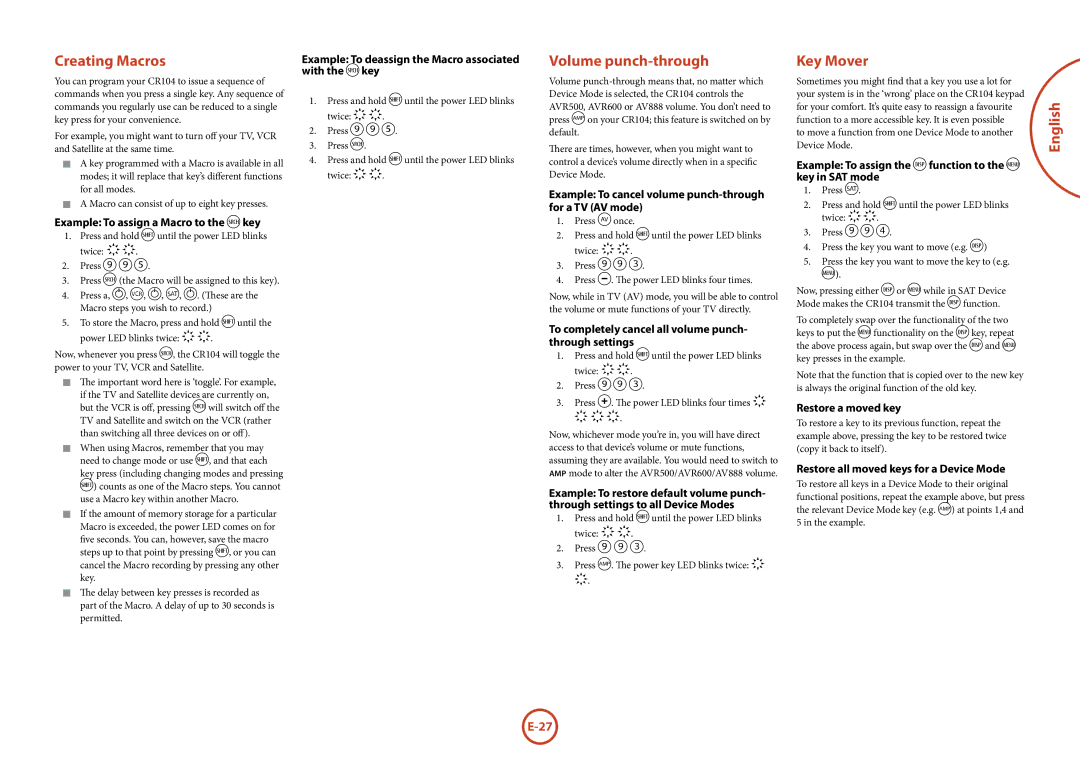
Creating Macros
You can program your CR104 to issue a sequence of commands when you press a single key. Any sequence of commands you regularly use can be reduced to a single key press for your convenience.
For example, you might want to turn off your TV, VCR and Satellite at the same time.
<A key programmed with a Macro is available in all modes; it will replace that key’s different functions for all modes.
<A Macro can consist of up to eight key presses.
Example: To assign a Macro to the hkey
1.Press and hold Suntil the power LED blinks twice: **.
2.Press 995.
3.Press h(the Macro will be assigned to this key).
4.Press a, P, w, P, z, P. (These are the Macro steps you wish to record.)
5.To store the Macro, press and hold Suntil the power LED blinks twice: **.
Now, whenever you press h, the CR104 will toggle the power to your TV, VCR and Satellite.
<The important word here is ‘toggle’. For example, if the TV and Satellite devices are currently on, but the VCR is off, pressing hwill switch off the TV and Satellite and switch on the VCR (rather than switching all three devices on or off).
<When using Macros, remember that you may need to change mode or use S, and that each key press (including changing modes and pressing S) counts as one of the Macro steps. You cannot use a Macro key within another Macro.
<If the amount of memory storage for a particular Macro is exceeded, the power LED comes on for five seconds. You can, however, save the macro steps up to that point by pressing S, or you can cancel the Macro recording by pressing any other key.
<The delay between key presses is recorded as part of the Macro. A delay of up to 30 seconds is permitted.
Example: To deassign the Macro associated with the hkey
1.Press and hold Suntil the power LED blinks twice: **.
2.Press 995.
3.Press h.
4.Press and hold Suntil the power LED blinks twice: **.
Volume punch-through
Volume
There are times, however, when you might want to control a device’s volume directly when in a specific Device Mode.
Example: To cancel volume punch-through for a TV (AV mode)
1.Press aonce.
2.Press and hold Suntil the power LED blinks twice: **.
3.Press 993.
4.Press
Now, while in TV (AV) mode, you will be able to control the volume or mute functions of your TV directly.
To completely cancel all volume punch- through settings
1.Press and hold Suntil the power LED blinks twice: **.
2.Press 993.
3.Press +. The power LED blinks four times *
* **.
Now, whichever mode you’re in, you will have direct access to that device’s volume or mute functions, assuming they are available. You would need to switch to AMP mode to alter the AVR500/AVR600/AV888 volume.
Example: To restore default volume punch- through settings to all Device Modes
1.Press and hold Suntil the power LED blinks twice: * *.
2.Press 9 9 3.
3.Press A. The power key LED blinks twice: * *.
Key Mover
Sometimes you might find that a key you use a lot for your system is in the ‘wrong’ place on the CR104 keypad for your comfort. It’s quite easy to reassign a favourite function to a more accessible key. It is even possible
to move a function from one Device Mode to another Device Mode.
Example: To assign the Dfunction to the U key in SAT mode
1.Press z.
2.Press and hold Suntil the power LED blinks twice: **.
3.Press 994.
4.Press the key you want to move (e.g. D)
5.Press the key you want to move the key to (e.g.
U).
Now, pressing either Dor Uwhile in SAT Device Mode makes the CR104 transmit the Dfunction.
To completely swap over the functionality of the two keys to put the Ufunctionality on the Dkey, repeat the above process again, but swap over the Dand U key presses in the example.
Note that the function that is copied over to the new key is always the original function of the old key.
Restore a moved key
To restore a key to its previous function, repeat the example above, pressing the key to be restored twice (copy it back to itself).
Restore all moved keys for a Device Mode
To restore all keys in a Device Mode to their original functional positions, repeat the example above, but press the relevant Device Mode key (e.g. A) at points 1,4 and 5 in the example.
